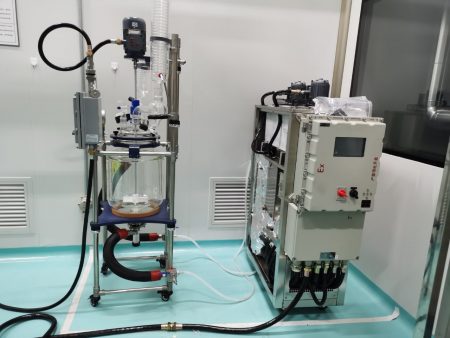Single Fluid Heating and Cooling Systems for Reactors
Principle of single fluid heating and cooling systems for reactors
1. Temperature sensor: Reactor temperature control systems usually use temperature sensors to monitor the temperature of the reactor in real time.
Common temperature sensors include thermocouples and thermistors, which convert temperature changes into electrical signals.
2. Controller: The controller is a component of the reactor temperature control system. It receives the signal from the temperature sensor and controls it according to the set temperature range.
The controller usually includes a PID control algorithm that can automatically adjust the output power of the heating or cooling device based on the difference between the real-time temperature and the set temperature to achieve stable temperature control.
3. Heating and cooling device: The heating and cooling device is the execution component of the reactor temperature control system. It adjusts the temperature of the reactor according to the instructions of the controller.
Common heating devices include electric heating wires and electric heating rods, while cooling devices can be cold water circulation systems or refrigerators.

Application of single fluid heating and cooling systems for reactors
1. Chemical synthesis: In the process of chemical synthesis, temperature is an important parameter.
The reactor temperature control system can help experimentalists control the stability of temperature during synthesis reactions and improve yield and product purity.
At the same time, the temperature control system can also avoid side reactions or product degradation caused by temperature fluctuations and improve the repeatability of the synthesis process.
2. Biological reactions: In biological reactions, the activity of cells or enzymes is usually closely related to temperature.
The reactor temperature control system can provide a stable temperature environment, maintain the activity of cells or enzymes, and improve reaction efficiency.
In addition, the temperature control system can also help control the rate and product selectivity of biological reactions, which is of great significance to the fields of bioengineering and pharmaceuticals.
3. Materials: In materials, temperature control has an important impact on the structure and performance of the material.
Single fluid heating and cooling systems for reactors can provide precise temperature control, help personnel observe material property changes at different temperatures, and provide important data for the development and application of new materials.
Ofrecemos diseño y fabricación de sistemas completos de control de temperatura. Desde modelos estándar hasta productos personalizados completos de hasta 900 toneladas. Nos especializamos en el servicio al cliente y nos dedicamos a ayudar a cada cliente a tener el sistema de control de temperatura óptimo para su necesidad específica.
Ofrecemos soluciones personalizadas no estándar. Disponemos tanto de enfriadoras individuales como de unidades combinadas de refrigeración y calefacción.
Correo electrónico: info@lneya.com WeChat ID: +8615251628237 WhatsApp: +86 17851209193

Enfriadoras y calefactoras
Rango de control de temperatura: -120°C a +350°C
termostato de refrigeración y calefacción, ampliamente utilizado en diversas industrias.
| Temperatura | Serie -10 ~ +150°C | Serie -25 ~ +200°C | Serie -25 ~ +300°C | Serie -45 ~ +250°C | Serie -45 ~ +300°C | Serie -60 ~ +250°C | Serie -60 ~ +300°C | Serie -70 ~ +250°C | Serie -80 ~ +250°C | Serie -90 ~ +250°C | Serie -100 ~ +100°C | ||
| Capacidad de refrigeración | 1,5 ~ 15 kW | 1 ~ 200 kW | 1 ~ 200 kW | 0,45 ~ 200 kW | 0,9 ~ 25 kW | 0,25 ~ 60 kW | 0,75 ~ 25 kW | 0,4 ~ 15 kW | 0,3 ~ 80 kW | 0,2 ~ 80 kW | 0,45 ~ 80 kW | ||
| Nota: Se puede personalizar cualquier rango de temperatura de -150℃ ~ +350℃ y cualquier capacidad de refrigeración. | |||||||||||||

Enfriadoras de recirculación
Rango de control de temperatura: -45°C a +250°C
| Temperatura | Serie -25°C ~ +200°C | Serie -45°C ~ +250°C | |||||||
| Capacidad de refrigeración | 1 ~ 15 kW | 0,25 ~ 15 kW | |||||||
| Nota: Se puede personalizar cualquier rango de temperatura de -150℃ ~ +350℃ y cualquier capacidad de refrigeración. | |||||||||
 LNEYA
LNEYA
 简体中文
简体中文


















































































